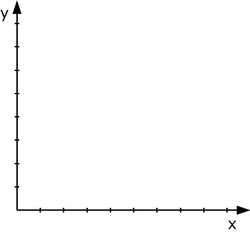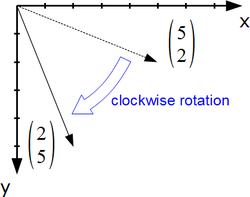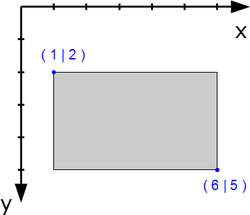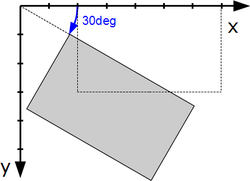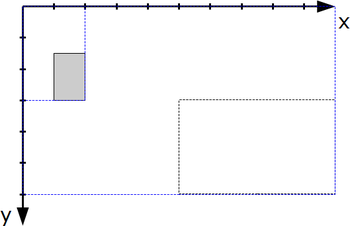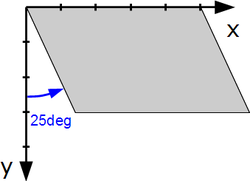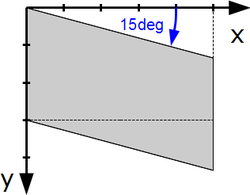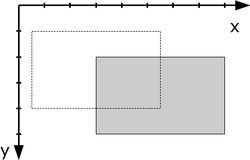Difference between revisions of "User:Regina/MYDrafts4"
| Line 38: | Line 38: | ||
| <tt>matrix(a b c d e f)</tt>, specifies a transformation in the form of a transformation matrix of six values. <tt>"</tt>The values describe... | | <tt>matrix(a b c d e f)</tt>, specifies a transformation in the form of a transformation matrix of six values. <tt>"</tt>The values describe... | ||
| Typo: The quotation mark before 'The values' has to be removed. | | Typo: The quotation mark before 'The values' has to be removed. | ||
| + | |||
| + | Problem: A standalone translation needs parameter with units. This information is missing here. | ||
|- | |- | ||
| <tt>rotate(rotate-angle)</tt>, specifies a rotation by <tt>rotate-angle</tt> degrees about the origin of the shapes coordinate system. | | <tt>rotate(rotate-angle)</tt>, specifies a rotation by <tt>rotate-angle</tt> degrees about the origin of the shapes coordinate system. | ||
| Line 75: | Line 77: | ||
[[File:SkewY15deg.png|250px|thumb|left|A rectangle transformed with <tt>skewY(15)</tt>]] | [[File:SkewY15deg.png|250px|thumb|left|A rectangle transformed with <tt>skewY(15)</tt>]] | ||
| + | |- | ||
| + | | <tt>translate( tx [ty])</tt>, specifies a translation by tx and ty, where tx and ty are lengths (18.3.18). | ||
| + | | In contrast to the other transformations, the parameters need a unit here. Therefore an example is useful. | ||
| + | |||
| + | Suggestion: | ||
| + | |||
| + | Example: The value <tt>translate(2.5cm 1cm)</tt> corresponds to the transformation matrix | ||
| + | <math>\begin{bmatrix}1&0&2.5\,\mbox{cm}\\ 0&1&1\,\mbox{cm} \end{bmatrix}</math> | ||
| + | |||
| + | [[File:TranslateX2komma5Y1.png|250px|thumb|left| A rectangle transformed with <tt>translate(2.5cm 1cm)</tt>]] | ||
|} | |} | ||
Revision as of 20:54, 9 August 2012
Problems With Angle Definitions in ODF1.2
Coordinate System
There are two common ways to orientate a Cartesian coordinate system.
Only when the orientation is determined, terms like "clockwise" are unambigious. Such orientation rule is missing in ODF 1.2.
Suggestion:
If a rule refers to a two-dimensional coordinate system, a Cartesian coordinate system in screen orientation (see figure ##) is used. The directions "clockwise", "counter clockwise", and the edge descriptions "left", "top", "right" and "button" are accordingly defined as shown in figures [##] to [##].
Angles in Attribute draw:transform
These suggestions are all about section 19.228. (Because of the Wiki markup I skipped the characters < and >).
I suggest to give for each single transformation value an example with reference to the corresponding transformation matrix and illustrate that example .
| Original | Problems and Suggestions |
|---|---|
| The whole original text is very near to SVG section 7, but a reference is missing. | |
| matrix(a b c d e f), specifies a transformation in the form of a transformation matrix of six values. "The values describe... | Typo: The quotation mark before 'The values' has to be removed.
Problem: A standalone translation needs parameter with units. This information is missing here. |
| rotate(rotate-angle), specifies a rotation by rotate-angle degrees about the origin of the shapes coordinate system. | The orientation of the rotation is missing. I suggest not to use "clockwise" but to define it by an equivalent matrix.
Suggestion: Example: The value rotate(30) corresponds to the transformation matrix |
| scale( sx [ sy ]), specifies a scale operation by sx and sy. | It is not clear, that not only the object is scaled.
Suggestion: Example: The value scale(0.2 0.5) corresponds to the transformation matrix |
| skewX(skew-angle), specifies a skew transformation by rotate-angle degrees along the x-axis. | Typo: "rotate-angle" should be "skew-angle".
Here is neither clear between which rays the angle is measured, nor what direction is used. Suggestion: Example: The value skewX(25) corresponds to the transformation matrix |
| skewY(skew-angle), specifies a skew transformation by rotate-angle degrees along the y-axis. | Same as skewX, typo "rotate-angle" and unclear angle.
Suggestion: Example: The value skewY(15) corresponds to the transformation matrix |
| translate( tx [ty]), specifies a translation by tx and ty, where tx and ty are lengths (18.3.18). | In contrast to the other transformations, the parameters need a unit here. Therefore an example is useful.
Suggestion: Example: The value translate(2.5cm 1cm) corresponds to the transformation matrix
|
